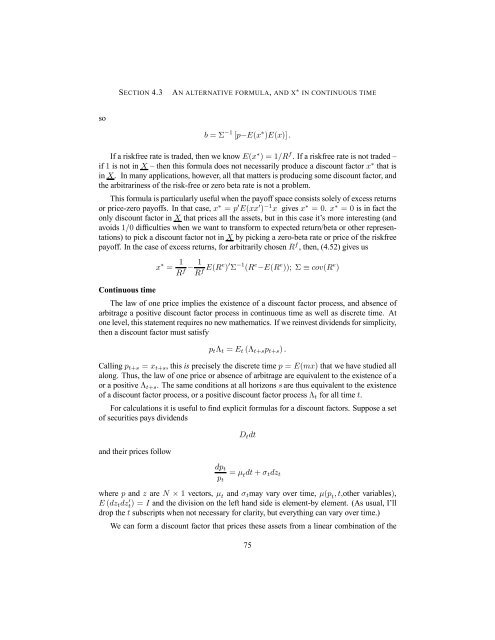Asset Pricing John H. Cochrane June 12, 2000
Asset Pricing John H. Cochrane June 12, 2000
Asset Pricing John H. Cochrane June 12, 2000
You also want an ePaper? Increase the reach of your titles
YUMPU automatically turns print PDFs into web optimized ePapers that Google loves.
so<br />
SECTION 4.3 AN ALTERNATIVE FORMULA, AND X ∗ IN CONTINUOUS TIME<br />
b = Σ −1 [p−E(x ∗ )E(x)] .<br />
Ifariskfreerateistraded,thenweknowE(x ∗ )=1/R f . If a riskfree rate is not traded –<br />
if 1 is not in X – then this formula does not necessarily produce a discount factor x ∗ that is<br />
in X. In many applications, however, all that matters is producing some discount factor, and<br />
the arbitrariness of the risk-free or zero beta rate is not a problem.<br />
This formula is particularly useful when the payoff space consists solely of excess returns<br />
or price-zero payoffs. In that case, x ∗ = p 0 E(xx 0 ) −1 x gives x ∗ =0. x ∗ =0is in fact the<br />
only discount factor in X that prices all the assets, but in this case it’s more interesting (and<br />
avoids 1/0 difficulties when we want to transform to expected return/beta or other representations)<br />
to pick a discount factor not in X by picking a zero-beta rate or price of the riskfree<br />
payoff. In the case of excess returns, for arbitrarily chosen R f , then, (4.52) gives us<br />
x ∗ = 1 1<br />
−<br />
Rf Rf E(Re ) 0 Σ −1 (R e −E(R e )); Σ ≡ cov(R e )<br />
Continuous time<br />
The law of one price implies the existence of a discount factor process, and absence of<br />
arbitrage a positive discount factor process in continuous time as well as discrete time. At<br />
one level, this statement requires no new mathematics. If we reinvest dividends for simplicity,<br />
then a discount factor must satisfy<br />
ptΛt = Et (Λt+spt+s) .<br />
Calling pt+s = xt+s, this is precisely the discrete time p = E(mx) that we have studied all<br />
along. Thus, the law of one price or absence of arbitrage are equivalent to the existence of a<br />
or a positive Λt+s. The same conditions at all horizons s are thus equivalent to the existence<br />
of a discount factor process, or a positive discount factor process Λt for all time t.<br />
For calculations it is useful to find explicit formulas for a discount factors. Suppose a set<br />
of securities pays dividends<br />
and their prices follow<br />
Dtdt<br />
dpt<br />
= µ tdt + σtdzt<br />
pt<br />
where p and z are N × 1 vectors, µ t and σtmay vary over time, µ(pt ,t,other variables),<br />
E (dztdz0 t)=I and the division on the left hand side is element-by element. (As usual, I’ll<br />
drop the t subscripts when not necessary for clarity, but everything can vary over time.)<br />
We can form a discount factor that prices these assets from a linear combination of the<br />
75
















